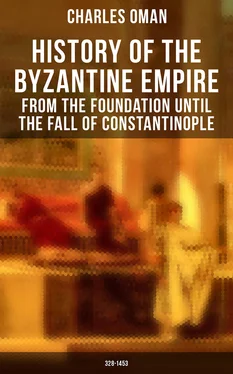In January of that year there was serious rioting in the streets. Justinian, though ordinarily he favoured the Blue faction, impartially ordered the leaders of the rioters on both sides to be put to death. Seven were selected for execution, and four of them were duly beheaded in the presence of a great and angry mob, in front of the monastery of St. Conon. The last three rioters were to be hung, but the hangman so bungled his task that two of the criminals, one a Blue the other a Green, fell to the ground alive. The guards seized them and they were again suspended; but once more—owing no doubt to the terror of the executioners at the menaces of the mob—the rope slipped. Then the multitude broke loose, the guards were swept away, and the half-hung criminals were thrust into sanctuary at the adjacent monastery.
This exciting incident proved the commencement of six days of desperate rioting. The Blues and Greens united, and taking as their watchword, Nika , “conquer,” swept through the city, crying for the deposition of John of Cappadocia, the unpopular finance minister, and of Eudemius, Praefect of the city, who was immediately responsible for the executions. The ordinary police of the capital were quite unable to master them, and Justinian was weak enough to promise to dismiss the officials. But the mob was now quite out of hand, and refused to disperse: the trouble was fomented by the partisans of the house of the late emperor, who began to shout for the deposition of Justinian, and wished to make Hypatius, nephew of Anastasius, Cæsar in his stead. The city was almost empty of troops, owing to the garrison having been sent to the Persian War. The Emperor could only count on 4,000 men of the Imperial Guard, a few German auxiliaries, and a regiment of 500 “Cataphracti,” mailed horsemen, under Belisarius, who had just returned from the seat of war.
Belisarius was placed in command of the whole, and sallied out to clear the streets, but the rioters, showing the same pluck that the Byzantine mob displayed against the soldiers of Gainas a hundred and twenty-five years before, offered a stout resistance. The main fighting took place around the great square of the Augustaeum, between the Imperial palace and the Hippodrome. In the heat of the fight the rebels set fire to the Brazen Porch by the Senate House. The Senate House caught fire, and then the conflagration spread east and north, till it was wafted across the square to St. Sophia. On the third day of the riot the great cathedral was burnt to the ground, and from thence the flames issued out to burn the hospital of Sampson and the church of St. Irene.9 The fire checked the fighting, and the insurgents were now in possession of most of the city. But they could not find their chosen leader, for the unfortunate Hypatius, who had no desire to risk his neck, had taken refuge with the Emperor in the palace. It was not till he was actually driven out by Justinian, who feared to have him about his person, that this rebel in spite of himself, fell into the hands of his own adherents. But on the sixth day of the riots they led him to the Hippodrome, installed him in the royal seat of the Kathisma, and crowned him there with a gold chain of his wife's, for want of a proper diadem.
 Theodora Imperatrix. From the Painting by Val. Prinsep. The copyright is in the Artist's hands.
Theodora Imperatrix. From the Painting by Val. Prinsep. The copyright is in the Artist's hands.
Meanwhile there was dismay and diversity of councils in the Palace. John of Cappadocia and many other ministers strove to persuade the Emperor to fly by sea, and gather additional troops at Heraclea. There was nothing left in his power save the palace, and they insisted that if he remained there longer he would be surrounded by the rebels and cut off from escape. It was then that the Empress Theodora rose to the level of the occasion, refused to fly, and urged her husband to make one final assault on the enemy. Her words are preserved by Procopius.
“This is no occasion to keep to the old rule that a woman must not speak in the council. Those who are most concerned have most right to dictate the course of action. Now every man must die once, and for a king death is better than dethronement and exile. May I never see the day when my purple robe is stripped from me, and when I am no more called Lady and Mistress! If you wish, O Emperor, to save your life, nothing is easier: there are your ships and the sea. But I agree with the old saying that ‘Empire is the best winding-sheet.’ ”
Spurred on by his wife's bold words, Justinian ordered a last assault on the rebels, and Belisarius led out his full force. The factions were now in the Hippodrome, saluting their newly-crowned leader with shouts of “ Hypatie Auguste, tu vincas ,” preparatory to a final attack on the palace. Belisarius attacked at once all three gates of the Hippodrome: that directed against the door of the Kathisma failed, but the soldiery forced both the side entrances, and after a hard struggle the rebels were entirely routed. Crowded into the enormous building with only five exits, they fell in thousands by the swords of the victorious Imperialists. It is said that 35,000 men were slain in the six days of this great “Sedition of Nika.”
It is curious to learn that not even this awful slaughter succeeded in crushing the factions. We hear of the Blues and Greens still rioting on various occasions during the next fifty years. But they never came again so near to changing the course of history as in the famous rising of a.d. 532.
Конец ознакомительного фрагмента.
Текст предоставлен ООО «ЛитРес».
Прочитайте эту книгу целиком, купив полную легальную версию на ЛитРес.
Безопасно оплатить книгу можно банковской картой Visa, MasterCard, Maestro, со счета мобильного телефона, с платежного терминала, в салоне МТС или Связной, через PayPal, WebMoney, Яндекс.Деньги, QIWI Кошелек, бонусными картами или другим удобным Вам способом.

 Theodora Imperatrix. From the Painting by Val. Prinsep. The copyright is in the Artist's hands.
Theodora Imperatrix. From the Painting by Val. Prinsep. The copyright is in the Artist's hands.










